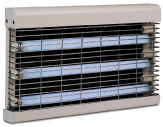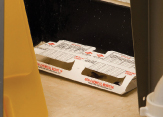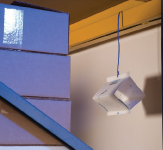
Green Pest Control: Tackling pests in a friendly (to the environment, at least) way.
June 12, 2008
By Patrick T. Copps
Green is no longer just a
buzzword, as evidenced by consumers’ increased demand for
environmentally friendly products. Your bakery may already be going
green by sourcing organic ingredients and using green cleaning
products, but did you know that your pest management program can also
go green?
Green is no longer just a buzzword, as evidenced by consumers’ increased demand for environmentally friendly products. Your bakery may already be going green by sourcing organic ingredients and using green cleaning products, but did you know that your pest management program can also go green?
 |
| Fly lights use UV light to draw flying insects into a unit where they become trapped on a non-toxic sticky surface. |
 |
| Report Card: Place sticky boards under equipment and in out-of-the-way places to trap crawling insects. |
 |
| Pheromone traps lure insects onto a sticky surface. These are especially effective in trapping stored-product pests like Indian meal moths. |
Routine applications of pesticides to control pests are a thing of the past. Progressive bakers are turning to green strategies to prevent pest problems. First and foremost you should implement a comprehensive Integrated Pest Management (IPM) program. IPM focuses on mitigating pests’ access to survival needs – food, water and shelter – through sanitation and facility maintenance. By preventing pests on the front end you can reduce the need for reactive treatments.
Green pest management techniques are most effective when used as part of an ongoing IPM process of inspection, preventive action and monitoring. Here are some tips you can implement to “green up” your pest management program:
Fly lights
Fly lights use UV light to draw flying insects into a unit where they become trapped on a non-toxic sticky surface. These should be installed next to doors that lead outside. Work with a pest management professional to ensure they are positioned correctly. Fly lights should trap insects that could inadvertently enter, but you don’t want the light to face outward and attract pests into your building.
Repellents
Small amounts of repellent dust help keep pests from hiding in hard-to-reach cracks and crevices in and around your facility. Commonly used to treat ants, repellents include a combination of silica gel and plant-derived pyrethrins to damage insects’ exoskeletons. Exposure to this combination leads pests to immediately retreat and causes their bodies to desiccate, or dry out. After applying repellents in small openings in the exterior of your building, consider sealing the openings with a good grade caulk to reduce the pests’ hiding spots and the chance of future infestations.
Sticky boards
As their name implies, sticky boards trap crawling insects on a sticky surface. Place sticky boards under equipment and in out-of-the-way places. Trapping crawling insects in this manner can help you to monitor for insect populations and alert you to the presence of pests before they can become established.
Pheromone traps and insect growth regulators
These two strategies use pests’ own biology against them. Pheromone traps use synthetic versions of insect pheromones to lure insects onto a sticky surface where they then become trapped. These are especially effective in trapping stored-product pests like Indian meal moths. Insect growth regulators (IGRs) use synthetic versions of insect hormones to prevent pests from reaching maturity, thereby preventing them from reproducing.
Non-volatile baits
Non-volatile baits like gels or bait pucks use chemical formulations that do not become airborne, making them a preferred option. Insects consume the bait and take it back to the nest – which helps to eliminate whole colonies. It’s important to work with a licensed professional when using baits as they do contain chemicals.
Organic cleaner
Organic cleaners use naturally occurring enzymes and good bacteria to break down the grease and grime that pests feed on without the use of harsh chemicals. Scrub drains thoroughly with a brush and an organic cleaner to remove the muck that drain flies use as a food source and breeding ground.
These are just a few of the green techniques that can help keep your IPM program running smoothly while making your bakery even more eco-conscious. IPM also speaks volumes with auditors as it is the most effective way to reduce pests and keep pesticides out of food production areas.
A successful IPM program relies on staff participation. Work with your pest management professional to train your staff to recognize and report any signs of pests. These include live or dead pests, droppings, gnaw marks and cast skins. Reporting and documenting pest sightings will help your pest management professional to identify the source of the activity and limit the need to use a pesticide. Also, early identification of a problem helps mitigate the issue before your facility or product can become infested.
Green business practices are here to stay and your bakery’s operations are a great place to start in making your business practices environmentally sound. Your customers will appreciate the forward thinking and, most of all, the action behind your eco-friendly approach. Auditors will acknowledge your commitment to serious pest management while your employees will appreciate your dedication to reducing the chemicals used around them. Reputable pest management providers will be glad to get you going on a green pest management program. Before you know it, your operations will be cleaner and greener while your products stay just as tasty as ever.
Patrick Copps is technical services manager for Orkin’s Pacific division. A board-certified entomologist in urban and industrial entomology, Copps has more than 30 years’ experience in the industry. For more information, send an e-mail to pcopps@rollins.com or visit www.orkincanada.com .
Print this page
Leave a Reply